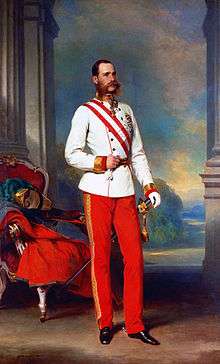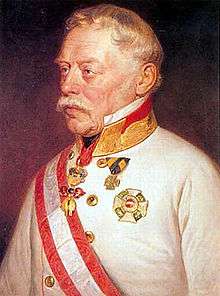Radetzky March (novel)
 | |
| Author | Joseph Roth |
|---|---|
| Original title | Radetzkymarsch |
| Country | Austria |
| Language | German |
| Genre | Novel |
Publication date | 1932 |
| Media type | Print (Hardback & Paperback) |
| ISBN | 978-1-58567-326-1 (English translation by Joachim Neugroschel) |
| OCLC | 124041549 |
| Followed by | The Emperor's Tomb |
Radetzky March (German: Radetzkymarsch) is a 1932 novel by Joseph Roth chronicling the decline and fall of the Austro-Hungarian Empire via the story of the Trotta family. Radetzkymarsch is an early example of a story that features the recurring participation of a historical figure, in this case the Emperor Franz Joseph I of Austria (1830–1916). Roth continues his account of the Trotta family to the time of the Anschluss in his The Emperor's Tomb (Kapuzinergruft, 1938). The novel was published in English translation in 1933, and in a new, more literal, translation in 1995.
Plot
Radetzky March relates the stories of three generations of the Trotta family, professional Austro-Hungarian soldiers and career bureaucrats of Slovenian origin — from their zenith during the empire to the nadir and breakup of that world during and after the First World War. In 1859, the Austrian Empire (1804–67) was fighting the Second War of Italian Independence (29 April – 11 July 1859), against French and Italian belligerents: Napoleon III of France, the Emperor of the French, and the Kingdom of Piedmont-Sardinia.

In northern Italy, during the Battle of Solferino (24 June 1859), the well-intentioned, but blundering, Emperor Franz Joseph I, and his cavalry cohort, are almost killed; to thwart snipers, Infantry Lieutenant Trotta topples the Emperor from his horse. The Emperor awards Lt. Trotta the Order of Maria Theresa and ennobles him. Elevation to the nobility ultimately leads to the Trotta family’s ruination, paralleling the imperial collapse of Austria-Hungary (1867–1918).
Subsequently, and without his desiring it, Lt. Trotta, now Baron Trotta, is regarded by his family — including his father — as a man of superior social class. Although he does not assume the airs of a social superior, everyone from the new baron’s old life perceives him as a changed person, as a nobleman. The perceptions and expectations of society eventually compel his reluctant integration in the aristocracy, a class with whom he is temperamentally uncomfortable.
As a father, the first Baron Trotta is disgusted by the historical revisionism that the national school system is teaching his son's generation. The school history textbook presents as fact a legend about his battlefield rescue of the Emperor; he finds especially galling the misrepresentation that infantry lieutenant Trotta was a cavalry officer.
The Baron complains to the Emperor to have the school book corrected. The Emperor counters that such truth would yield an uninspiring, pedestrian history, useless to Austro-Hungarian patriotism; therefore, whether or not history textbooks report Infantry Lt. Trotta’s battlefield heroism as legend or as fact, he orders the story deleted from the official history of Austria-Hungary. Consequently, the subsequent Trotta family generations misunderstand the elder generation’s reverence for the legend of Lt. Trotta’s saving the life of the Emperor and consider themselves to be rightful aristocrats.
The disillusioned Baron Trotta opposes his son’s aspirations to a military career, insisting he prepare to become a government official, the second most respected career in the Austrian Empire; by custom, the German son was expected to obey. The son eventually becomes a district administrator in a Moravian town. As a father, the second Baron Trotta (still ignorant of why his war-hero father thwarted his military ambitions) sends his own son to become a cavalry officer; grandfather’s legend determines grandson’s life. The cavalry officer’s career of the third Baron Trotta comprises postings throughout the empire of Austria-Hungary and a dissipated life of wine, women, song, gambling, and dueling, off-duty pursuits characteristic of the military officer class in peace-time. In the progress of his career, Baron Trotta’s infantry unit suppresses an industrial strike in the garrison town; awareness of the aftermath of his professional brutality begins his disillusionment with empire.
Literary and critical significance

Radetzky March is Joseph Roth's best-known work. It was first published in English in 1995 and was widely acclaimed. In 2003 the German literary critic Marcel Reich-Ranicki included it in Der Kanon ("The Canon") of the most important German-language literary novels. It is a novel of the ironies and humour inherent in the well-intentioned actions that lead to the decline and fall of a family and an empire; the Emperor Franz Josef I of Austria-Hungary remains ignorant of the unintended, negative consequences of so rewarding his subjects, and he continues conferring great favours, as with Lt. Trotta, after the Battle of Solferino in 1859.
.jpg)
The novel's title derives from the Radetzky March, Op. 228 (1848), by Johann Strauss Sr. (1804–49), which honours the Austrian Field Marshal Joseph Radetzky von Radetz (1766–1858). It is a symbolic musical composition heard at critical narrative junctures of the Trotta family history.
During an interview on the United States TV show, Charlie Rose, Peruvian writer Mario Vargas Llosa ranked The Radetzky March as the best political novel ever written.[1]
First edition of the novel with epilogue and commentary: Joseph Roth: Radetzkymarsch. Ed. by Werner Bellmann. Stuttgart: Reclam, 2010 (540 pages). The text is based on the first edition (1932, 1st.-12th. Thousand).
Translations
Radetzky March has been translated into various languages. A notable translation was done by the poet Michael Hofmann, who has translated a number of other works by Joseph Roth. The first persian translation was done by Mohammad Hemmati and published by Nashre Now publications in 2016.